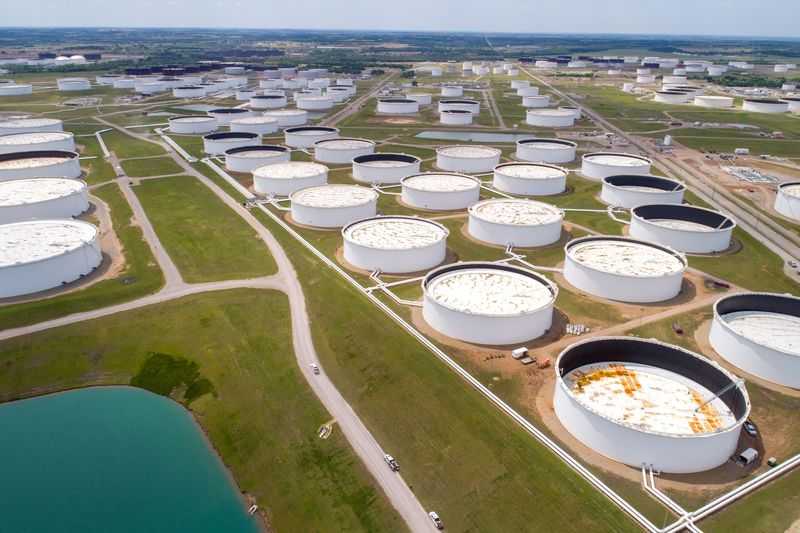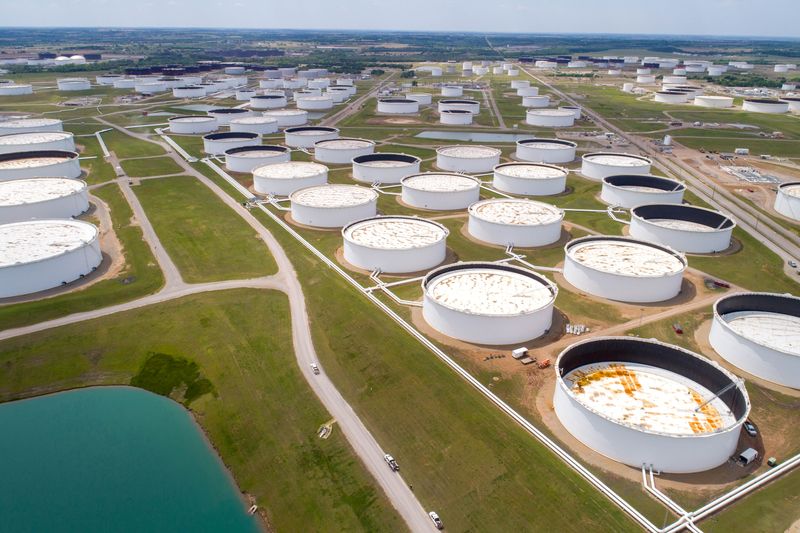Commodities
Oil prices rise as US inventory data reflect robust demand


© Reuters. FILE PHOTO: Crude oil storage tanks are seen in an aerial photograph at the Cushing oil hub in Cushing, Oklahoma, U.S. April 21, 2020. REUTERS/Drone Base/File Photo
By Ahmad Ghaddar
LONDON (Reuters) – Oil prices surged on Wednesday, trading near their highest levels since April, buoyed by crude and fuel product inventory data showing robust U.S. demand.
futures for October were up 44 cents, or 0.5%, to $85.35 a barrel by 0949 GMT. U.S. West Texas Intermediate crude for September climbed 48 cents, or 0.6%, to $81.85 a barrel.
inventories fell by 15.4 million barrels in the week ended July 28, according to market sources citing American Petroleum Institute figures, compared with analysts’ estimates for a drop of 1.37 million barrels.
If the U.S. government figures, due later on Wednesday, match the API drawdown number, it would mark the largest drop in U.S. crude inventories according to records dating back to 1982.
Gasoline inventories fell by 1.7 million barrels, the API data showed, compared with estimates for a 1.3 million barrel drop. Distillate stocks fell by 510,000 barrels, compared with analysts estimates for a build of 112,000 barrels. Both are indicators of robust prompt fuel demand in the U.S.
“For most of the last two weeks it has been to products that oil has looked for its forward leanings, but the overnight remarkable draws in the API data sees crude take over the bull baton and give the market another spurring on,” PVM Oil analysts said.
Crude oil inventories have also begun to drop in other regions as demand outpaces supply, which has been constrained by deep production cuts from Saudi Arabia, the de facto leader of the Organization of the Petroleum Exporting Countries (OPEC), that has provided price support.
Analysts expect Saudi Arabia to extend its voluntary oil output cut of 1 million barrels per day (bpd) for another month to include September in a meeting of producers on Friday.
OPEC+, which groups OPEC and allies led by Russia, is unlikely to tweak its current oil output policy when a panel meets on Friday, six OPEC+ sources told Reuters, as tighter supplies and resilient demand drive an oil price rally.
Concerns that oil buying in China, the world’s biggest oil importer, may slow as prices rise. Weak PMI data released this week indicated fuel demand may be weaker than expected.
“Chinese crude buying has been opportunistic rather than due to higher demand. (The) market continues to be driven purely by supply constraints, which are always subject to potential political volatility,” said Sparta Commodities’ Philip Jones-Lux.
Commodities
Oil prices rise; U.S. crude inventories plunge, Russia-Ukraine truce eyed
Commodities
India’s Reliance to stop buying Venezuelan oil over US tariffs, sources say
Commodities
Oil prices climb on Venezuela supply worries

 Forex3 years ago
Forex3 years agoForex Today: the dollar is gaining strength amid gloomy sentiment at the start of the Fed’s week

 Forex3 years ago
Forex3 years agoUnbiased review of Pocket Option broker

 Forex3 years ago
Forex3 years agoDollar to pound sterling exchange rate today: Pound plummeted to its lowest since 1985

 Forex3 years ago
Forex3 years agoHow is the Australian dollar doing today?

 Cryptocurrency3 years ago
Cryptocurrency3 years agoWhat happened in the crypto market – current events today

 World3 years ago
World3 years agoWhy are modern video games an art form?

 Commodities3 years ago
Commodities3 years agoCopper continues to fall in price on expectations of lower demand in China

 Economy3 years ago
Economy3 years agoCrude oil tankers double in price due to EU anti-Russian sanctions























